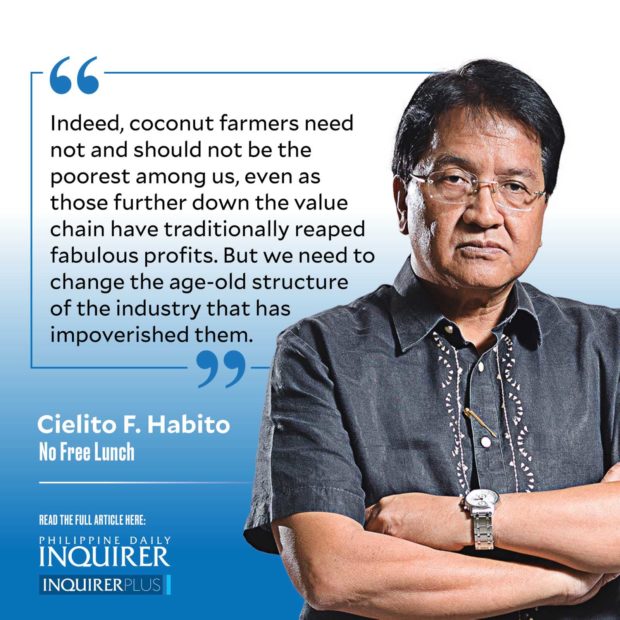Coconut has traditionally been described as the “lazy man’s crop,” where farmers simply wait for the nuts to mature in 2-3-month cycles between harvests — and hardly doing anything in between. The crop is estimated to earn the farmer an average of P20,000 per hectare per year, and with the average farm barely a hectare in size, it clearly cannot support an average family’s minimum needs. Little wonder, then, that coconut farmers have long been identified to be the poorest among our rural poor, along with small fishers. Coconut farming simply cannot be the primary source of livelihood for a farm family, and usually is not. Studies show that coconut-farming families earn more from intercrops planted under the coconut trees, or from non-farm sources.
Worse, coconut prices have always been volatile, subject to the wild fluctuations in the world vegetable oils market, where palm oil, soybean oil, sunflower oil, and others are substitutes. This is because the bulk of our coconuts are still sold as copra, turned into coconut oil by millers who buy it in bulk from traders. These traders, who often advance credit to the farmers in exchange for assured supply of their harvest, make a hefty margin in the process.
But there’s so much more economic value to be derived from virtually every part of the coconut tree, earning it another nickname as the “tree of life.” Apart from coconut oil and desiccated coconut, of which we are the top global exporter, coconut can be turned into a wide array of products that include the now popular coconut water, activated carbon, coco chemicals, coco diesel, virgin coconut oil, coco sugar, nutritious ubod (heart of palm), geotextiles, nutriceuticals, coir fiber, coco lumber, handicrafts, and so many more down to the lowly walis tingting (stick brooms made from coconut leaf stems). Coconut could well be our most versatile farm crop, but 80 percent of industry output remains in the form of copra for coconut oil, and much of the rest get discarded.
The situation borders on irrationality in times when copra prices are so low that farmers literally burn potentially higher-valued coconut shells and husks in order to dry lower-valued copra. Fixated on a product whose world price fluctuates wildly, the industry misses out on vast opportunities—and potentially much more income for the farmer.
Indeed, coconut farmers need not and should not be the poorest among us, even as those further down the value chain have traditionally reaped fabulous profits. But we need to change the age-old structure of the industry that has impoverished them.
Enter the Philippine Coconut Authority, soon to unveil a Coconut Farmers’ and Industry Roadmap mandated under the new law on the disposition of the long-contested Marcos-era coconut levy funds. It plots new directions for an industry in dire need of revitalization, through innovative technology, product diversification, collectivization of farmers into cooperatives, and more. The roadmap must define clear targets toward dramatically reducing the prominence of copra and coconut oil, with a corresponding increase in focus on other higher-value products from the crop. This is crucial if we are to delink farmers’ low and volatile incomes from the vagaries of the global vegetable oils market.
Cooperatives are key for clustering otherwise powerless small farmers, whose objective should be far more than the old aim of merely grouping them for greater bargaining power in selling their primary product. As co-ops, farm producers can become higher value-adding and higher-earning entrepreneurs and be direct drivers of Secretary William Dar’s agri-industrialization thrust. The special challenge here is the need to integrate key intercrops like coffee, cacao, and others into the co-ops’ product lines, if they are to be responsive to the full range of opportunities in a modern coconut farming system. It’s obviously easier said than done, but the substantial resources from the coconut levy proceeds would help. And with strong cooperation and coordination among all sectors concerned, the lazy man’s crop can yet become a wealthy man’s crop for our erstwhile lowly coconut farmers.


